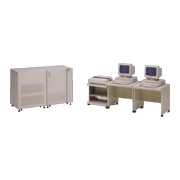This office computer from Mitsubishi Electric was announced in 1987. It achieved performance rivaling small general-purpose computers by using high-speed processing technology.
This machine used a high-speed bipolar 32-bit VLSI processor for the central processing unit (CPU), and a pipeline control system which improved performance by segmenting instruction execution into a number of stages, and executing the different stages in parallel. It also achieved higher performance by equipping with 32 kilobytes of cache memory for reading out instructions and data at a speed much faster than the main memory unit, and further, dividing the cache into two parts: instruction cache and operand cache. This made it possible to increase the speed of high-volume database processing and image processing involving very large amounts of information.
The main memory unit was a maximum of 32 megabytes -- among the largest among office computers -- and in combination with the CPU's dynamic address translation (DAT) mechanism, enabled execution of large programs with leeway to spare. The hard disk could also be expanded to a maximum of 6.4 gigabytes. This was the first office computer to have dual arithmetic circuits in its central processing unit, and checking was done by performing arithmetic processing with the two circuits and then comparing the results. This helped to ensure reliability. Maintainability and availability were improved by using a built-in service processor (SVP) to perform tasks like system control and state diagnosis, and display/recording of the situation when an error occurred.

- Home >
- Historical Computers in Japan >
- Office Computers >
- MELCOM80 System 80G
【Mitsubishi Electric】 MELCOM80 System 80G
 | ||
| MELCOM80 System 80G |
All Rights Reserved, Copyright (C) Information Processing Society of Japan
